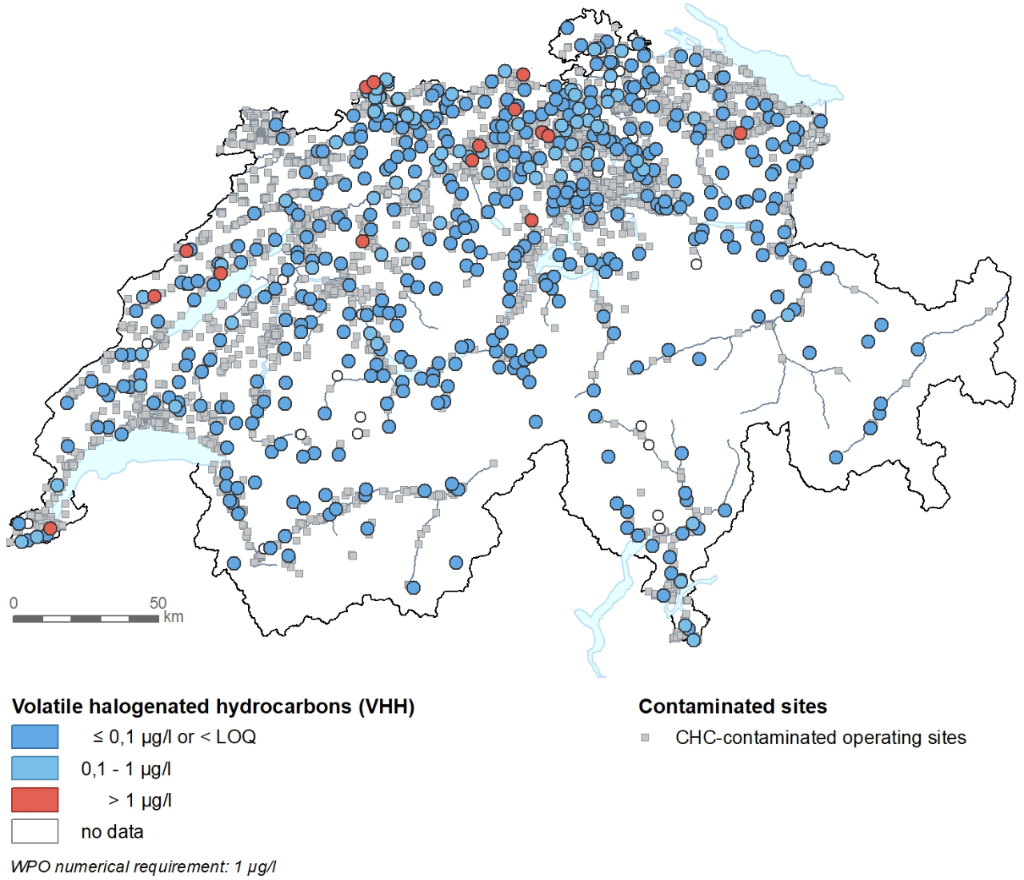Volatile halogenated hydrocarbons are the most frequently detected volatile organic compounds (VOC) in groundwater, exceeding the limit value at 3% of monitoring sites. In contrast, monocyclic aromatic hydrocarbons (MAH) and polycyclic aromatic hydrocarbons (PAH) are only rarely found.
According to the Waters Protection Ordinance (WPO), groundwater should generally not contain any persistent synthetic substances. For groundwater that is used for drinking water or is intended for such use, there is also a limit value ('numerical requirement') of 1 microgram per litre (µg/l) for volatile halogenated hydrocarbons (VHH) and monocyclic aromatic hydrocarbons (MAH); and of 0,1 µg/l for polycyclic aromatic hydrocarbons (PAH).
Volatile halogenated hydrocarbons most frequently detected
At 25% of monitoring sites nationwide, volatile halogenated hydrocarbons were detected in the groundwater, the limit value being exceeded at 3% of the monitoring sites. In predominantly urban catchment areas, VHH concentrations are above the limit value at 10% of the monitoring sites. The limit value of 1 µg/l is most frequently exceeded by tetrachloroethene.
Volatile halogenated hydrocarbons mainly originate from contaminated sites, such as contaminated former industrial or commercial plants or old landfills. In the past, these substances were used in large quantities as solvents and cleaning agents in industry and commerce and became present in the environment, primarily in the second half of the 20th century, because of inappropriate handling. Once in the groundwater, VHH resist degradation and therefore still contaminate the groundwater to this day.
In 2020 monocyclic and polycyclic aromatic hydrocarbons did not exceed their respective limit values. MAH were detected at 3% of monitoring sites, while PAH were only present at two monitoring sites.
The petrol additive MTBE, for which the WPO does not prescribe a limit value, was detected at more than 3% of the monitoring sites in concentrations of up to 1,0 µg/l. The maximum level in drinking water prescribed by the Drinking Water Ordinance (DWBSO) of 5 µg/l for the combined presence of MTBE and ETBE was not exceeded.
Volatile halogenated hydrocarbons slightly declining
Between 2007 and 2020, the number of monitoring sites at which volatile halogenated hydrocarbons were detected in concentrations of more than 1 µg/l fell from 5% to 3%.
The number of monitoring sites with concentrations of tetrachloroethene above 1 µg/l also decreased significantly.
Further information
Documents
Zustand und Entwicklung Grundwasser Schweiz
Last modification 23.08.2022






